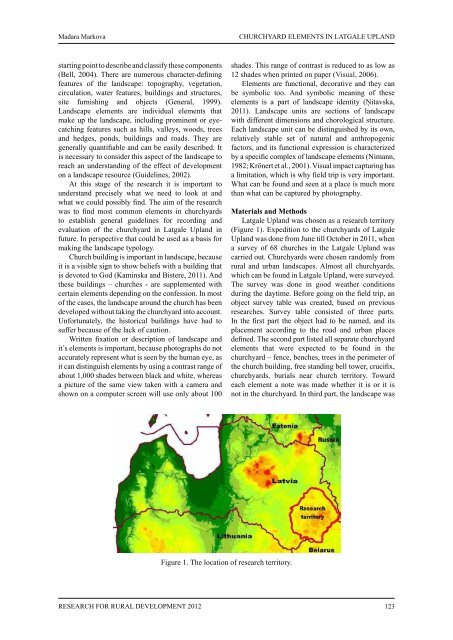RESEARCH FOR
RESEARCH FOR
RESEARCH FOR
Create successful ePaper yourself
Turn your PDF publications into a flip-book with our unique Google optimized e-Paper software.
Madara Markova CHURCHYARD ELEMENTS IN LATGALE UPLAND<br />
starting point to describe and classify these components<br />
(Bell, 2004). There are numerous character-defining<br />
features of the landscape: topography, vegetation,<br />
circulation, water features, buildings and structures,<br />
site furnishing and objects (General, 1999).<br />
Landscape elements are individual elements that<br />
make up the landscape, including prominent or eyecatching<br />
features such as hills, valleys, woods, trees<br />
and hedges, ponds, buildings and roads. They are<br />
generally quantifiable and can be easily described. It<br />
is necessary to consider this aspect of the landscape to<br />
reach an understanding of the effect of development<br />
on a landscape resource (Guidelines, 2002).<br />
At this stage of the research it is important to<br />
understand precisely what we need to look at and<br />
what we could possibly find. The aim of the research<br />
was to find most common elements in churchyards<br />
to establish general guidelines for recording and<br />
evaluation of the churchyard in Latgale Upland in<br />
future. In perspective that could be used as a basis for<br />
making the landscape typology.<br />
Church building is important in landscape, because<br />
it is a visible sign to show beliefs with a building that<br />
is devoted to God (Kaminska and Bistere, 2011). And<br />
these buildings – churches - are supplemented with<br />
certain elements depending on the confession. In most<br />
of the cases, the landscape around the church has been<br />
developed without taking the churchyard into account.<br />
Unfortunately, the historical buildings have had to<br />
suffer because of the lack of caution.<br />
Written fixation or description of landscape and<br />
it’s elements is important, because photographs do not<br />
accurately represent what is seen by the human eye, as<br />
it can distinguish elements by using a contrast range of<br />
about 1,000 shades between black and white, whereas<br />
a picture of the same view taken with a camera and<br />
shown on a computer screen will use only about 100<br />
ReseaRch foR RuRal Development 2012<br />
Figure 1. The location of research territory.<br />
shades. This range of contrast is reduced to as low as<br />
12 shades when printed on paper (Visual, 2006).<br />
Elements are functional, decorative and they can<br />
be symbolic too. And symbolic meaning of these<br />
elements is a part of landscape identity (Ņitavska,<br />
2011). Landscape units are sections of landscape<br />
with different dimensions and chorological structure.<br />
Each landscape unit can be distinguished by its own,<br />
relatively stable set of natural and anthropogenic<br />
factors, and its functional expression is characterized<br />
by a specific complex of landscape elements (Nimann,<br />
1982; Krönert et al., 2001). Visual impact capturing has<br />
a limitation, which is why field trip is very important.<br />
What can be found and seen at a place is much more<br />
than what can be captured by photography.<br />
materials and methods<br />
Latgale Upland was chosen as a research territory<br />
(Figure 1). Expedition to the churchyards of Latgale<br />
Upland was done from June till October in 2011, when<br />
a survey of 68 churches in the Latgale Upland was<br />
carried out. Churchyards were chosen randomly from<br />
rural and urban landscapes. Almost all churchyards,<br />
which can be found in Latgale Upland, were surveyed.<br />
The survey was done in good weather conditions<br />
during the daytime. Before going on the field trip, an<br />
object survey table was created, based on previous<br />
researches. Survey table consisted of three parts.<br />
In the first part the object had to be named, and its<br />
placement according to the road and urban places<br />
defined. The second part listed all separate churchyard<br />
elements that were expected to be found in the<br />
churchyard – fence, benches, trees in the perimeter of<br />
the church building, free standing bell tower, crucifix,<br />
churchyards, burials near church territory. Toward<br />
each element a note was made whether it is or it is<br />
not in the churchyard. In third part, the landscape was<br />
123


